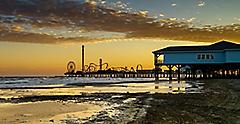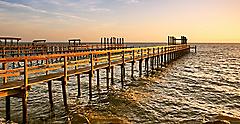From the state's renowned Painted Churches in the Hill Country to the massive sky-scraping cathedrals in Texas's largest cities, visitors of various faith traditions can be inspired by these architectural gems. Whenever you're up for a Lone Star state road trip, add these to your itinerary as worthy stopping points for a peek at architecture as well as an opportunity to uncover local history and Texas culture as you plan a vacation getaway before your cruise out of Galveston.
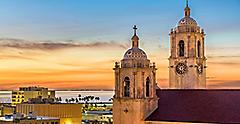
Visiting South Texas Cathedrals
In San Antonio, you'll find the oldest cathedral to visit in Texas: the San Fernando Cathedral. The build began in 1738, so the San Fernando Cathedral predates the establishment of modern-day Texas as we know it. The origins of the church began in 1731 with 15 families from the Canary Islands who traveled to this region invited by Spain's King Phillip V. Though floods and fires have threatened to bring it down over the centuries, the cathedral still stands tall in San Antonio's Main Plaza, just steps from the famed San Antonio River Walk.
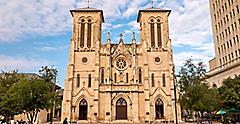
The San Fernando Cathedral showcases perfect symmetry between its two bell towers, which are connected by a Gothic Revival nave (the main body of the church) in between and three arched doors. The cathedral has served as the setting of many important moments throughout history. James Bowie, a prominent figure from the Texas Revolution, married Ursula de Veramendi inside the cathedral, and the building was used by Mexican troops during the siege of Bexar during the Texas Revolution.
Today, the cathedral is integral to the community. It hosts thousands of people for weekend mass, as well as weddings, baptisms and funerals. And since 2014, the exterior of the church has served as a canvas for the popular light show called The Saga, which depicts the story of San Antonio's history through colorful lights and joyful music. Shows are free, and you can watch them throughout the week.
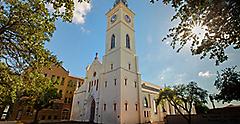
Heading south to Laredo, the San Agustín Cathedral — which originates back to 1755 — was built when a group of Spanish families sought a Catholic church in which they could worship. In those days, the church was little more than a hut on the corner of Zaragoza Street and San Agustín Avenue. In 1788, in order to fit the hundreds of families who were coming here to worship, a small stone church was built. Now a massive, ornate Gothic Revival church, you can still see the outline of this original structure today on the face of the church. The cathedral has had many iterations over the years, but it now has a distinct white plaster facade and pristine white interior, with a row of columns and Gothic stained glass leading to the altar. Father Pierre Yves Kéralum, a French-born missionary who studied architecture in France before becoming a priest, designed the structure. Its Gothic-spired clock tower rises over the San Agustín Plaza — an integral place of community, both socially and economically, for the city of Laredo.
Gothic Revival architecture can be found all throughout Texas. Along the Texas/Mexico border, you'll land in Brownsville, where you can visit another Kéralum-designed cathedral that actually predates the San Agustín Cathedral — the Immaculate Conception Cathedral. Located at the city's center, the cathedral was completed in 1856. The exterior stuns with painted bricks and a layered arched doorway. Inside, a regal blue canvas ceiling with ribbed vaulting has been restored to its original splendor.
Traveling To The West Texas Cathedrals
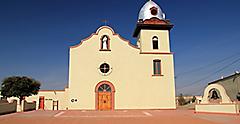
Similar to Brownsville, the Catholic Church's importance in the Texas/Mexico border region grew in the wake of the Mexican Constitution of 1917 and the Mexican Revolution, a time of anticlerical laws that pushed Catholic seminarians to flee as they travel across the border to the United States to study and practice their religion. El Paso became a haven for many of these seminarians.
It's in El Paso that the majestic St. Patrick Cathedral stands — a Byzantine basilica in the Italian Renaissance style built in 1917. The structure is faced with brown pressed brick and marble. Though a golden spire topped with a cross has oxidized to green over the years, a historic El Paso Times article commented on how the cross was "outlined against the mountains at sunset in such a way that it reflects the sunset glow, giving a most striking effect." Touring these historical churches helps to round out the story of the earliest roots of Catholicism in Texas. Each unique design narrates what was happening in the time period in which it was built.
Making A Day Trip Seeing Dallas/Fort Worth Cathedrals
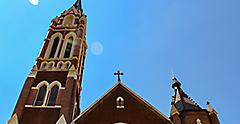
Take Time To Go To Central Texas Cathedrals
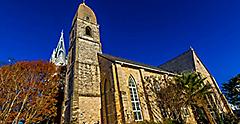
Many German and Czech settlers came to live in the region of Central Texas in the 1800s and early 1900s after fleeing the religious oppression in their home countries. In their new towns, the settlers constructed beautiful cathedrals to honor their faith and their homelands. The Texas Painted Churches are among these cathedrals. Twenty painted churches exist in all, dotting the Texas Hill Country — notably in the town of Schulenburg. They are known for their beautifully hand-painted frescoes in homage to European churches. Hill Country visitors can arrange for a guided tour.
Head to Fredericksburg to see one example of the Texas Painted Churches at St. Mary's Catholic Church. It has a beautifully painted interior with intricate trompe l'oeil imagery of the Twelve Apostles. St. Mary's is an example of a cathedral built for the area's large number of German Catholics. The Gothic-style church started with humble wooden beginnings in the 1850s. It then lead to the erection of the "little church," called Marienkirche or Old St. Mary's in 1863, which is still standing. The largest of the cathedrals was built in 1906, standing 137 feet tall. Visitors may take a guided tour of the buildings after Sunday Mass.
In Austin, the St. Mary Catholic Cathedral took root in 1852 — the same year the Texas Capitol building was completed. The church is a Gothic revival design also by Clayton. He wanted to use the structure to evoke nature, such as vines and flowers, and created a blue dome resembling the night sky. The church combines elements such as locally quarried limestone with stained-glass windows imported from Germany and France.
Experiencing The Texas Gulf Coast Cathedrals

When European immigrants came to Texas, they didn't typically come through New York's Ellis Island. Rather, the island of Galveston was the first U.S. soil they would see after their long journey. Because of religious persecution against Catholics in Germany, many of them came eager to practice their faith. Throughout the 1800s, Galveston was known as the "Ellis Island of the West" due to its busy immigration port. Today, Galveston remains a busy and important port destination for Texas.
Thus, it makes sense that Galveston would be the site of the oldest German Catholic church in Texas. St. Joseph's Church is a humble, wooden Gothic Revival church built in 1859 by some of Texas's early German immigrants. The exterior of the building is painted white with green shutters and features a square bell tower. The interior includes painted quatrefoil and other designs. The 1900 Storm — the deadliest natural disaster in U.S. history — wreaked havoc upon the island and its populace. It damaged this church but did not destroy it, and it has been repaired and built upon throughout the years. Though not in operation, the structure is maintained by the Galveston Historical Foundation and is open for special events and prearranged tours.
For a glimpse at a fully operating Galveston Catholic cathedral, go to St. Mary Cathedral Basilica, the island's oldest existing church building. It was constructed in 1847 in a Gothic Revival style inspired by the architecture of King's College Chapel in Cambridge, England. The cathedral takes a traditional cruciform design, in the shape of a cross, and was given a tower topped by a statue of Mary and double spires by architect Clayton. Long ago, sailors used to scan for Mary's golden crown in order to guide them to port. Inside, wooden columns and ribbed vaulting combined with an ornate painted ceiling impart a distinctly rich historical vibe.
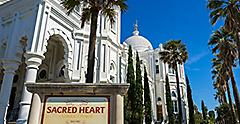
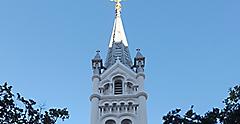
Head to Houston for yet more captivating cathedral architecture. At the corner of Texas Avenue and Crawford Street stands the oldest operating church in Houston: Annunciation Catholic Church. Legend has it that, following the Civil War in 1866, a local priest named Father Joseph Querat sought to expand worship space for his Catholic brethren, so he bought an old courthouse for $1,000 and dismantled and cleaned the bricks for the new cathedral. Prolific cathedral architect Clayton designed this church, too, in his signature Gothic style, and the building was dedicated in 1871. The cathedral's Romanesque-style of rounded arches and a grand bell tower is complemented by a beautifully painted interior with a long dome ceiling.
Each region has its own long history and relationship with religion and community. A tour of the ornate cathedral architecture of Texas is one of the best ways to learn the history of this remarkable state.
Admire the unique cathedral architecture in Texas on a cruise from Galveston.
Get Royal Deals, Sign Up Today

Getting There
Explore Our Most Affordable Itineraries
Admire the unique cathedral architecture in Texas on a cruise from Galveston.



